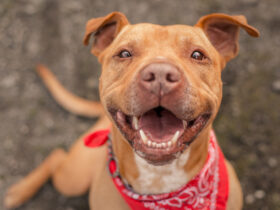During the winter it’s important to know that even though our dogs may have a built-in fur coat, winter months and frigid temperatures can present challenges for our four-legged family members.
Can Dogs Get Cold?
Just like humans, dogs can get cold, especially during the dead of winter. While their fur provides some level of insulation, no dog is completely immune to the changing of the season. It is crucial that as a pet parent, you pay close attention to your dog’s behavior and take appropriate measures to keep them safe and warm in colder seasons.
How Cold Is Too Cold for My Dog?
According to DVM Jennifer Coates, it’s time to limit your dog’s outdoor activities once the temperature falls below 45 degrees. While it’s not necessarily dangerous, dogs with shorter hair and little or no undercoat will start to feel uncomfortable on these colder days. Once the temperature hits 32 degrees or below, small dogs, dogs that are not built for winter, young puppies, and older dogs should have limited time outdoors.
Of course, there are cold-weather dog breeds, such as an Alaskan Malamute, Siberian Husky, or Samoyed, that have more protection and sometimes prefer cold temperatures. However, pet parents should still monitor these cold-weather dogs when they’re outside. Dr. Coates recommends paying especially close attention to dogs when it’s below 20 degrees.
Although it is important to know how cold is too cold for dogs, it’s also crucial to remember that temperature isn’t the only factor to consider. Wind chill, moisture levels, and snow can further affect how a dog reacts to being outside. The simplest rule of thumb is that if it’s too cold for you, it’s probably too cold for your best friend to be out longer than a few minutes for a bathroom break.
How Does Cold Weather Affect Dogs?
Cold weather impacts dogs in several ways. Just like in humans, freezing temperatures can cause hypothermia and frostbite quickly. Winter conditions also create other dangers for our furry friends. Slippery surfaces can cause dogs to slip and fall, which can lead to a variety of potentially serious injuries.
Another thing pet parents need to take into consideration is that the cold is particularly tough on our dog’s paws. Chunks of ice, snow, or rock salt can lodge themselves between your dog’s paw pads and cut their feet. Prolonged exposure to salt and other de-icing chemicals can lead to chemical burns and even make your best friend more susceptible to frostbite.
Signs Your Dog is Cold and Needs to Come Inside
There are a variety of signs that your dog is too cold. Make sure to periodically check on your dog and look for these signals to determine when it’s time to come back inside.
- Whimpering, whining, or excessive barking. This is your dog trying to “verbally” say it’s too cold.
- Unwillingness to move. If your dog stops walking or playing and starts prancing on their feet or holding up a paw, it’s time to go indoors. When you get inside, check their paws for any snow or ice lodged in their foot pads.
- Shivering. Simply put, a shivering dog has had enough of the cold.
- Signs of anxiety. Some dogs become anxious when they are too cold. They may even become fearful and turn around, trying to head back toward home.
- Looking for a hiding place. Some dogs will look for shelter under a car, a bush, somewhere else when they’re too cold. If your dog starts hiding, it’s time to head inside and warm up.
6 Winter Safety Tips for Pet Parents
Cold weather can pose problems for your pup, but there are measures you can take to help your dog enjoy the winter wonderland safely and comfortably! Here are a few other ways you can help your dog stay healthy and warm during the winter season.
Limit time outdoors
The best way to prevent cold weather issues is to stop them before they happen. For example, just like you wouldn’t want to be stuck in a cold car all by yourself, neither does your best friend. Never leave your dog in the car when it’s cold outside and avoid putting them out in below-freezing temperatures. Instead, opt to spend more quality playtime indoors during the colder months and limit cold weather outdoor activities.
Support your dog with a healthy diet
Pet parents can take a proactive approach to protecting their dog during the colder months by choosing a diet that supports their pup’s specific nutritional needs. Packed with essential nutrients to help support lean muscle tone, dry dog food like Bil-Jac Adult Select provides the support dogs need to maintain everyday health, a crucial element in navigating slippery and icy conditions during the winter.
Give your dog a good wipe down when coming back indoors
After a walk, wipe down your dog’s paws. This practice will help clear away any ice or debris that collect there.
Dress your dog for the cold weather
If your pup doesn’t mind clothes, a sweater and some booties can help protect your dog from the cold. Just keep in mind that dogs lose most of their body temperature through their paws, noses, and mouths. Clothes can help ward off some of the cold, but you shouldn’t rely on furry fashion as a perfect cold weather solution.
Check your dog’s collar and chip
It only takes a quick slip on some ice to lose your footing and accidentally drop your pup’s leash. If this happens and your dog takes off, they can easily become lost. In the winter, snow and ice mask the smells they may normally use to find their way home. Be sure your dog is wearing proper identification and that any microchip information is up to date.
Keep Your Best Friend Happy and Warm This Season
A few precautions and a little information go a long way toward enjoying a happy, healthy winter with your four-legged friend. Want to learn more about how you can support your dog all year round? Sign up for our Best Friends Club today to receive our special newsletter with helpful articles, training tips, and members-only discounts on Bil-Jac products.







Leave a Reply